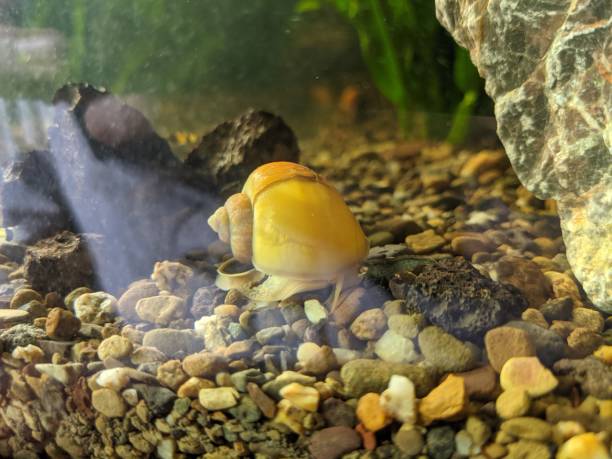Decoding the Enigmatic World of Aquatic Snails
Aquatic snails, often overlooked inhabitants of our freshwater ecosystems, harbor a fascinating array of secrets beneath their spiral shells. These tiny mollusks play crucial roles in maintaining the delicate balance of aquatic environments, yet their complex behaviors and unique adaptations remain largely unknown to many. From their diverse feeding habits to their surprising longevity, aquatic snails offer a captivating glimpse into the intricacies of underwater life.

The Diverse Realm of Aquatic Snails
Aquatic snails encompass a vast array of species, each adapted to specific freshwater habitats. From the common pond snail to the exotic Nerite snail, these gastropods exhibit an astounding variety of shapes, sizes, and colors. Some species, like the Malaysian Trumpet Snail, have evolved to burrow in substrate, while others, such as the Apple Snail, prefer to float near the water’s surface. This diversity reflects the remarkable adaptability of aquatic snails to various ecological niches within freshwater ecosystems.
Ecological Champions of Freshwater Habitats
Despite their small size, aquatic snails play a vital role in maintaining the health of freshwater environments. As natural algae eaters, they help control excess algal growth, preventing the suffocation of other aquatic plants and animals. Additionally, their feeding habits contribute to the recycling of nutrients in the ecosystem, promoting overall biodiversity. Some species even serve as bioindicators, their presence or absence signaling changes in water quality and environmental conditions.
Surprising Longevity and Reproduction
Contrary to popular belief, many aquatic snail species boast impressive lifespans. While some smaller varieties may live for only a year, larger species like the Mystery Snail can survive for up to five years under optimal conditions. Their reproductive strategies are equally fascinating, with some species capable of both sexual and asexual reproduction. This adaptability allows them to rapidly populate new environments and recover from population declines.
The Rise of Snail-Keeping in the Aquarium Hobby
In recent years, there has been a surge of interest in keeping aquatic snails as part of home aquariums. Enthusiasts appreciate their algae-eating capabilities and the unique aesthetic they bring to underwater landscapes. Popular species like the Zebra Nerite Snail, known for its striking black and white stripes, can command prices ranging from $3 to $10 per snail. This growing trend has led to increased research into snail care and breeding, expanding our understanding of these captivating creatures.
Challenges and Conservation Efforts
While many aquatic snail species thrive, others face threats from habitat destruction, pollution, and invasive species. Conservation efforts are underway to protect vulnerable populations, with researchers studying the impact of environmental changes on snail communities. These initiatives not only aim to preserve biodiversity but also to harness the potential of aquatic snails in water quality monitoring and ecosystem restoration projects.
Unveiling the Secrets of Snail Senses
Recent studies have shed light on the surprisingly sophisticated sensory capabilities of aquatic snails. Despite their simple appearance, these mollusks possess complex chemoreceptors that allow them to detect minute changes in water chemistry. This sensory prowess enables snails to locate food sources, avoid predators, and even recognize potential mates. Researchers are now exploring how these sensory abilities could be applied in the development of new environmental monitoring technologies.
The Culinary Controversy: Snails as Food
While land snails have long been considered a delicacy in many cultures, the consumption of freshwater snails remains a topic of debate. Some species, such as the Giant African Land Snail, have gained popularity in certain cuisines. However, concerns about parasites and sustainable harvesting practices have led to increased scrutiny of this practice. The aquaculture of edible snail species is an emerging field, with potential implications for both gastronomy and conservation.
Snails in Science: From Medicine to Materials
Aquatic snails are proving to be valuable subjects in various scientific fields. Their mucus, rich in unique compounds, is being studied for potential medical applications, including wound healing and antimicrobial properties. Additionally, the structure of snail shells has inspired innovations in materials science, with researchers exploring biomimetic designs for stronger, more efficient structures. These developments highlight the unexpected ways in which these small creatures could contribute to advancements in human technology and health.
The Future of Aquatic Snail Research
As our understanding of aquatic snails grows, so does the potential for new discoveries. Ongoing research focuses on unraveling the genetic diversity within snail populations, exploring their role in ecosystem services, and investigating their potential as bioremediation agents in polluted waters. The future of aquatic snail research promises exciting insights into biodiversity conservation, ecosystem management, and the development of bio-inspired technologies.
Appreciating the Unsung Heroes of Freshwater Ecosystems
From their vital ecological roles to their potential in scientific research, aquatic snails emerge as unsung heroes of our freshwater worlds. As we continue to uncover the mysteries of these fascinating creatures, it becomes clear that their importance extends far beyond their humble appearances. By fostering a greater appreciation for aquatic snails, we not only enrich our understanding of underwater ecosystems but also open doors to innovative solutions for environmental challenges and scientific advancements.





